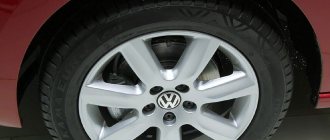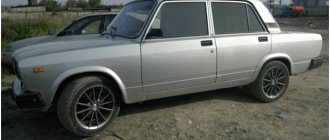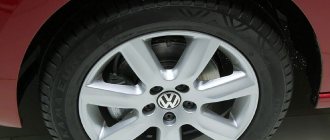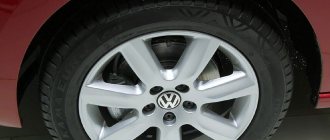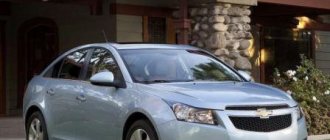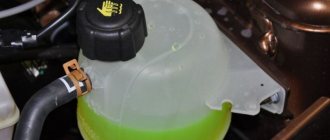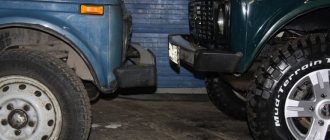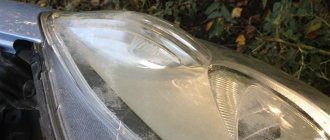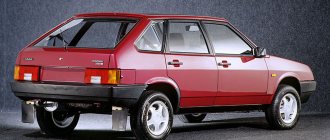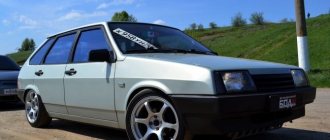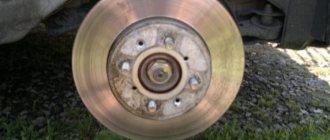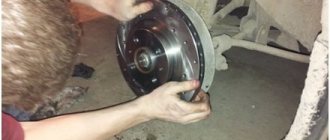Today, several options for wheel rims are available, which are usually divided both by the method of their manufacture and by the material from which they are made.
The main types of rims are:
- Stamped (stamping/steel);
- Cast (light alloy/casting);
- Forged (forging);
- Composite (collapsible/prefabricated);
- Other types.
Stamped discs are the most affordable and also the heaviest in weight. The remaining options fall into the category of alloy wheels, which weigh less and cost more.
In terms of design, alloy wheels have the widest choice, while forged wheels are the most durable. Among alloy wheels, composite wheels are the most expensive.
Let's figure out what pros and cons each option has.
Stamped discs
Such discs are the simplest and cheapest option, which is usually installed by automakers on budget cars in order to reduce the final cost.
Manufacturing
Stamped wheels are made from steel ; the stamping method is used for manufacturing.
pros
Among the main advantages of steel wheels are low cost, sufficient strength, and high maintainability (which is quite important when the vehicle is actively used on roads with poor surfaces).
Minuses
- Heavy weight compared to analogues, almost complete lack of choice in terms of design, as well as low anti-corrosion resistance.
- The increased mass of stamped disks causes increased fuel consumption, decreased dynamics, deterioration of controllability, as well as premature failure of individual chassis elements. Also, in some cases, the comfort of the driver and passengers suffers.
- In practice, owners have to regularly paint stamped wheels, as well as use plastic hubcaps to improve the appearance of the wheels and the car as a whole.
Of course, there are exceptions (for example, branded 5-spoke “stamps” on Opel models or expensive original hubcaps that very successfully imitate alloy wheels), but in most cases the stamped wheel looks standard.
How wheel weight affects acceleration
One of the main parameters that directly affects the speed and dynamics of any car is the weight of the wheel rims. Every experienced car owner knows well that by reducing the weight of the discs, an amazing effect can be achieved: increasing the smoothness of the ride, increasing the maximum speed and making the car's handling easier and safer. But in order to make the effect of improving dynamics more attractive, you need to understand how weight affects each of the above parameters.
Alloy wheels
These rims are designated cast , are the most common option and are often associated with the concept of “customization”.
Today you can buy cheap alloy wheels from unknown manufacturers (the cost of such wheels is no more expensive than high-quality stamping), medium-priced “mass” solutions from well-known brands, or expensive original factory wheels for cars from the middle and premium segment. Exclusive solutions and tuning wheels also deserve special attention.
Manufacturing
The main manufacturing material for such disks is various aluminum alloys. Titanium or magnesium alloy is used less frequently (relevant for expensive versions). A cast disc is made by pouring an alloy into a special mold. Next, the material cools, after which it is removed from the mold and goes through several stages of mechanical processing.
Let us also add that today manufacturers have more advanced technologies for manufacturing alloy wheels. For example, injection molding . In this production, the melted aluminum, which is poured into the mold, is also additionally subjected to a certain pressure. The result is a reduction in the porosity of the material. Thanks to the pressure, a more integral fine-grained structure is formed, which makes the material noticeably stronger.
Another method is the “ flow forming ” technology. It is based on a method of mechanically rolling out the rim directly on a hot blank. The rolling method allows you to achieve high strength while reducing the overall weight. By the way, the method is reminiscent of the technology for producing forged wheels. The only disadvantage is that casting, which is made using the methods described above, costs much more than conventional cast wheels.
pros
- Among the main advantages of high-quality alloy wheels are light weight and sufficient strength , which reduces fuel consumption, improves vehicle acceleration and handling, increases comfort and reduces the load on the suspension.
- You can also highlight the widest selection of alloy wheels in terms of design and size, which allows you to choose the right option for almost any car. Moreover, the selection of wheels for a car can be carried out taking into account a number of requirements, wishes and individual preferences of the customer.
Minuses
- Repair of alloy wheels does not have good repairability;
- High probability of loss of appearance as a result of minor mechanical damage, after the wheels are in an aggressive environment, etc.
- First of all, cast wheels do not wrinkle (unlike stamping), but simply crack. For example, a casting that falls into a hole can both immediately crack and gradually accumulate microcracks. It is in the second case that there is a danger of subsequent splitting of the disk even after a minor impact.
- Also, cast wheels are distinguished by average performance and characteristics in a number of basic parameters. Even in practice, car enthusiasts note that the use of cast wheels compared to stamped wheels in certain situations can cause failure of suspension parts, as well as damage to tires.
For example, if a stamped wheel falls into a hole, it will be crushed but not burst. In this case, part of the impact energy falls on the disc, and not on the suspension. In the case of an alloy wheel, the energy is transferred to the vehicle's chassis. If the disk splits due to an impact, often the sharp edges literally tear the tire itself.
Landing diameter
The bore diameter is the size of the wheel circumference in inches. Depending on the tire size, it can vary by one to three inches. Information about the permissible disc diameter is usually indicated by the manufacturer, and it should be selected according to the make and model of the car. Slight confusion is caused by the designation of the parameter - using the letter “R”, for example R15 or R17 - many people mistake this designation for the radius. This is the diameter!
Larger wheels look cooler, but the larger the wheel size, the greater the load on the suspension parts, reducing the tire profile and reducing its shock-absorbing properties. And smaller wheels may not fit on the brake caliper.
Forged wheels
This type of wheel is designated forged , and is the most durable and lightest compared to analogues. They are usually installed on powerful production cars and sports cars, and are also actively used in professional motorsport. Forging is also in great demand as a solution for all kinds of exclusive projects and civil tuning.
Manufacturing
The technology for producing forged wheels is actually the stamping of a heated solid workpiece (blank), after which subsequent mechanical processing is performed.
As a rule, the material is aluminum; less commonly, other alloys can be used.
We also note that forged wheels can also be produced using a technology that involves cutting a disk from a blank on a special machine. This type of forging is less durable than traditionally made forged wheels, but they are still much stronger than cast wheels.
As a rule, this method allows us to produce exclusive custom-made solutions, unique “designer” forged wheels, limited edition wheels, etc. However, real sports forged wheels are produced exclusively by high-pressure stamping. The fact is that only the traditional press stamping method can give the aluminum alloy the highest strength.
pros
Among the main advantages of forged wheels are the highest strength and low weight. At the same time, manufacturers, even taking into account the high complexity of manufacturing and restrictions, still have the opportunity to create stylish forged wheels that are not inferior to cast ones in appearance. The only caveat is a narrower selection of models.
Minuses
- Given that the manufacturing process for forged wheels is complex, forging designs do not have as many different options as castings.
- Serious disadvantages include high cost and low maintainability. In practice, forged wheels in one case can crack (similar to cast wheels), and in another they can just bend like stamping. One way or another, the loads that forged wheels can withstand are much higher compared to even the highest quality castings.
Bolt pattern
If the bolt pattern is incorrect, it will not be possible to tighten the wheel. Wheel bolt pattern is determined by two parameters:
- number of mounting holes;
- diameter of their location (PCD).
The diameter of the circle on which the mounting holes are located, as well as their number, are specified by the car manufacturer and this parameter should be strictly adhered to. Installing a disk with a PCD deviation of even a couple of millimeters will lead to the fact that such a wheel will “beat” strongly while driving. In addition, loose bolts will unscrew on their own.
For installation, special nuts and bolts are used for fastening the wheels. They can be purchased at tire centers and auto parts stores.
Collapsible disks
Collapsible rims (similar terms - composite/combined/assembled rims) are usually designated 2-piece or 3-piece. These discs are not solid, but are a prefabricated structure of 2 or 3 components. Such wheels are often used as solutions for car tuning.
Manufacturing
Typically, the central part of the disc, which includes the spokes and hub, is made by casting. This means that in terms of design, as with any other casting, there are no restrictions. Forging can also be used to give greater strength, but this solution is used much less frequently.
pros
- The rim of a compound disc is often forged, making it very durable. The central part is attached to the rim using titanium bolts. The resulting overall structure is stylish in design, lightweight and durable.
- The maintainability of combined wheels is higher than that of other light-alloy analogues. Often it is possible to replace only the damaged part, and not the entire disk.
Minuses
The disadvantages of such wheels include their high cost, which can often be at the same level or even higher than high-quality forging. Please note that composite disks, especially taking into account the peculiarities of their production, cannot be cheap. If there are budget versions of such wheels on the market, they are usually a low-grade fake.
Peculiarities
Let us also add that prefabricated disks can consist of either two or three parts. In the three-piece version, the rim has both an internal part and an external part. This allows the manufacturer to flexibly change certain disk parameters: rim width, offset, shelf depth.
Also, car enthusiasts in different countries practice replacing one component parts of wheels with others, which allows them to assemble wheels taking into account not only the intended purpose, but also a number of individual preferences.
Price range
It starts at two thousand rubles and ends at approximately 50 thousand.* The average cost is 5-7 thousand. The most expensive wheels today are WSP ITALY Tornado. They will cost $1500.
A car can't be ugly
Wheels are an integral part of a car, they can be different. But the essence is the same: this is a detail of the movement and grace of any four-wheeled “toy” of the twenty-first century.
*Prices are current as of January 2022.
Other types of disks
Finally, we note that the main types and types of rims were discussed above. However, that's not all. Also worth noting are spoked wheels , which are installed on various versions of retro cars and other wheeled vehicles.
There are also composite wheels that are installed on supercars (plastic and carbon are used, among other materials), as well as custom wheels as part of various individual projects.
One way or another, we will not consider them within the framework of this article, since the main attention was paid exclusively to mass products.
Basic principles of care
In order for discs to last longer, they need to be looked after.
Such events include:
- washing;
- drying;
Important!
Washing with water jet is more effective than wiping with a cloth.
- polishing;
Or rubbing with an abrasive - a substance for polishing metals. Usually this is corundum, emery. For polishing you need: an abrasive and a polishing machine. You can use a microfiber cloth instead, but the results are better when using technology.
- balancing;
You may be interested in this About stamped R15 rims
A responsible and necessary stage. If the car is not balanced correctly, it creates vibrations and handling becomes worse.
- storage;
Try to avoid the formation of condensation; to do this, do not seal the discs tightly. You can use a preservative aerosol to cover the surface with a thin protective layer. The rims should not be adjacent to each other.
What not to do
Treat with gasoline and other solvents: they destroy the paint.
Important!
In case of severe damage, all four discs will have to be replaced. If scratches or other “abnormalities” are detected, action should be taken immediately.
Smooth ride
Calculations show that reducing the weight of each wheel by at least one kilogram is equivalent to reducing the weight in the cabin by 40 kilograms. In practice, we can give the following example: if you reduce the weight of each wheel by four kilograms (this is not difficult to do, considering how much one forged rim weighs), then the smoothness of the ride will be the same as if you had four passengers in the cabin. Overclocking characteristics will remain at the same level.
The answer to the question “Which wheels are lighter, forged or cast?” everyone knows. For example, one original 20-inch cast rim for Range Rover weighs about 25 kilograms. A forged analogue with a maximum static load for the same car is about 13 kilograms. Each wheel is approximately 12 kg lighter. As a result, forged wheels make it possible to reduce unsprung weight by almost half a ton, and improved ride smoothness is achieved without loss of dynamics and acceleration characteristics.
Sprung and unsprung mass
To better understand the relationship between the weight of a car wheel and its dynamic characteristics, it is necessary to take into account all the forces that act on the vehicle while driving. Experienced engineers and designers at automobile factories always pay attention to one important indicator - the difference between the unsprung and sprung masses of the car.
From the point of view of engineering science, the sprung mass includes all elements and parts of the vehicle that are located between the spring and the body (i.e., separated from the road surface). Conversely, unsprung mass is everything that is located between the road and the car's springs. If you correctly redistribute the proportion of these two indicators, you can increase braking efficiency, improve the smoothness of the ride and increase the dynamic qualities of the car.
